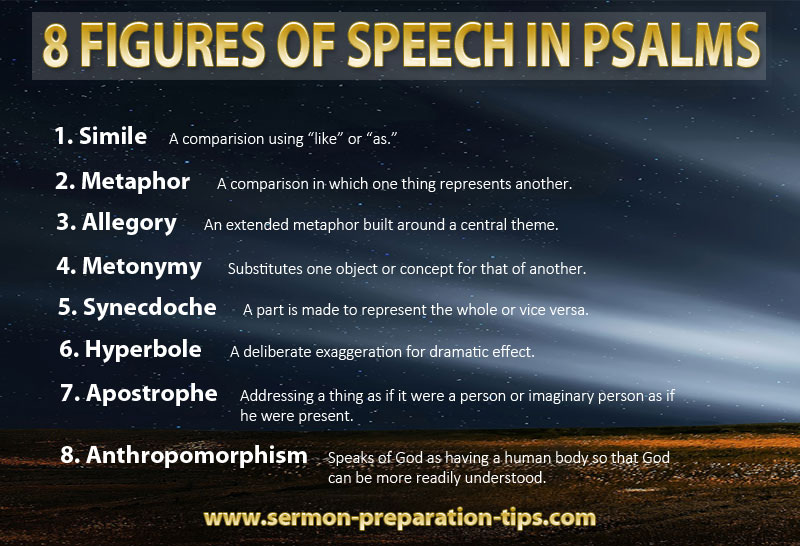Figures of Speech in Psalms: Hebrew poetry has a distinctive type of language that uses illustrative expressions known as figures of speech to bring warmth, vividness and vitality to biblical poetry.

Figures of Speech in Psalms
Ryken explains that “poetry is heightened speech, far more compressed than prose. Whereas expository prose uses the sentence or paragraph as its basic unit, and narrative the episode or scene, the basic unit of poetry is the individual image or figure of speech.”
“Thus in the New Testament epistles we might get a paragraph or chapter that explains godliness. In a historical narrative we get a story in which a character exhibits godliness in action. But the poet compresses godliness into an image or picture: ‘He is like a tree planted by streams of water that yields its fruit in its season’” (Psalm 1:3; Leland Ryken, Words of Delight, p. 159).
In light of the above, it is therefore important to understand imagery and figures of speech in psalms. What are they and how do they work? The following figures of speech are the most common used in the psalms.
1. Simile
The simile makes a comparison between two objects by using the word like or as. In Psalm 1:3 we read that the godly man is like a tree planted by streams of water and in Psalm 1:5 we read that the ungodly man is like chaff. The comparison states the godly man will grow and prosper but the ungodly man will wither and perish.
2. Metaphor
The metaphor is similar to the simile without the use of like or as. The metaphor makes a comparison between two objects by stating one to be like another. If we use Psalm 1:3 and Psalm 1:5 as an example, we would state that the godly man is a tree planted by streams of water and the ungodly man is chaff that is blown away and perishes.
“The Lord is my shepherd, I shall not be in want” (Psalm 23:1) Notice it doesn’t say the Lord is like my shepherd; it says that the Lord is my shepherd. The psalmist states one to be like another without using like or as.
3. Allegory
An allegory is a series of extended metaphors built around a central theme. One good example of this is Psalm 80:8-16). This allegory or extended metaphor of the vine and vineyard describes the changed condition of Israel. “You brought a vine out of Egypt; you drove out the nations and planted it. You cleared the ground for it, and it took root and filled the land. The mountains were covered with its shade, the mighty cedars with its branches. It sent out its boughs to the sea, its shoots as far as the river. Why have you broken down its walls so that all who pass by pick its grapes? Boars from the forest ravage it and the creatures of the field feed on it. Return to us, O God Almighty! Look down from heaven and see! Watch over this vine, the root your right hand has planted, the son you have raised up for yourself. Your vine is cut down, it is burned with fire; at your rebuke your people perish” (Psalm 80:8-16).
4. Metonymy
The metonymy is a figure of speech that substitutes one object or concept for that of another to which it is related. In Psalm 73:9 the tongue is substituted for mouth. “Their mouths lay claim to heaven, and their tongues take possession of earth.”
“Create in me a pure heart, O God, and renew a steadfast spirit within me.” (Psalm 51:10). A steadfast spirit is substituted for a pure heart.
5. Synecdoche
The synecdoche is a figure of speech in which a part is made to represent the whole or vice versa. Psalm 24:4 is an example of a synecdoche. Hands and heart represent the whole of one’s life. “He who has clean hands and a pure heart, who does not lift up his soul to an idol or swear by what is false” (Psalm 24:4).
6. Hyperbole
The hyperbole is a figure of speech that conveys a concept using a deliberate exaggeration for dramatic effect. Hyperbole does not claim to convey literal truth but instead conveys emotional truth. Hyperbole falls into the category of poetic license and therefore not intended to be interpreted as literal fact.
“The earth trembled and quaked, and the foundations of the mountains shook; they trembled because he was angry. Smoke rose from his nostrils; consuming fire came from his mouth, burning coals blazed out of it” (Psalm 18:7-8).
7. Apostrophe
An apostrophe is a figure of speech that addresses a thing as if it were a person or an absent or imaginary person as if he were present. It is sometimes combined with personification treating a lifeless object as though it is a person.
“Lift up your heads, O gates” (Psalm 24:7); Glorious things are spoken of you, O city of God” (Psalm 87:3); “Bless the Lord, O my soul” (Psalm 103:1).
8. Anthropomorphism
An anthropomorphism is a figure of speech that speaks of God as having a human body so that we can understand God more readily. “Arise, LORD! Lift up your hand, O God. Do not forget the helpless” (Psalm 10:12).
“Turn your ear to me, come quickly to my rescue; be my rock of refuge, a strong fortress to save me” (Psalm 31:2).

Some Concluding Comments
When it comes to the exposition of biblical poetry, it is important to understand figures of speech in psalms, types of parallelism in Hebrew poetry and the different types of psalms. Putting all this together will help you preach the psalms to your congregation.
Some Resources For Figures of Speech in Psalms
Words of Delight: A Literary Introduction to the Bible by Leland Ryken
Holman Old Testament Commentary of the Psalms (Volume 1 & Volume 2) by Steven J. Lawson
An Expositional Commentary of the Psalms (Volume 1, Volume 2 and Volume 3) by James Montgomery Boice
A Commentary of the Psalms (Volume 1, Volume 2 and Volume 3) by Allen P. Ross
The NIV Application Commentary of the Psalms (Volume 1) by Gerald H. Wilson
The Dictionary of Biblical Imagery by Leland Ryken
The Ideal of Biblical Poetry: Parallelism and Its History by James Kugel
The Dynamics of Biblical Parallelism by Adele Berlin
Figures of Speech in the Bible: Explained and Illustrated by E.W. Bullinger